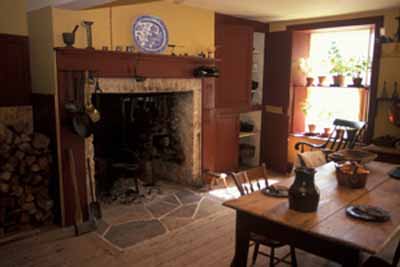Matheson House National Historic Site of Canada
Perth, Ontario

Interior view
© Parks Canada Agency / Agence Parcs Canada, J. Butterill, 1995.
Address :
11 Gore Street East, Perth, Ontario
Recognition Statute:
Historic Sites and Monuments Act (R.S.C., 1985, c. H-4)
Designation Date:
1966-05-25
Dates:
-
1840 to 1840
(Construction)
-
1970 to 1970
(Significant)
-
1930 to 1947
(Significant)
-
1947 to 1966
(Significant)
Event, Person, Organization:
-
Roderick Matheson (owner)
(Person)
-
Arthur James Matheson (owner)
(Person)
-
Peter John Stokes (refurbisher)
(Person)
Other Name(s):
-
Matheson House
(Designation Name)
-
Archibald M. Campbell Museum
(Other Name)
-
Perth Museum
(Other Name)
Research Report Number:
1966-034,1993-005, 2005-SDC/CED-045
Plaque(s)
Existing plaque: East side of Gore St. Mounted on wall of building on right side of front door. 11 Gore Street East, Perth, Ontario
Built in 1840 of local sandstone, the Matheson House is an outstanding example of early Scottish-Canadian architecture. Its design is imposing, its stonework remarkably fine, and it occupies a key position in one of the best surviving streetscapes in Canada characteristic of this important architectural tradition. The house was originally owned by the Hon. Roderick Matheson, a prominent citizen of Perth and one of the Dominion's first senators. It remained in the possession of the Matheson family for nearly 100 years.
Description of Historic Place
The Matheson House National Historic Site of Canada is located in the heart of old Perth, in Ontario. Built in 1840 by Roderick Matheson, a merchant of Scottish origin, the house is an elegant, Palladian-inspired residence typical of houses of the affluent in pre-Confederation Canada. A relatively late example of its type, the two-storey, five-bay sandstone house is of classical design with a symmetrical principal elevation with projecting frontispiece crowned by a pediment. The house is unusual in that it was part of a group of family-owned buildings including a store, two warehouses and a coach house, all of which have survived as part of the streetscape on Gore and Foster Streets. Official recognition refers to the building on its legal lot at its time of designation.
Heritage Value
The Matheson House was designated a national historic site of Canada in 1966 because: it is an outstanding example of early Scottish-Canadian architecture; it occupies a key position in one of the best surviving streetscapes in Canada characteristic of this important architectural tradition; it was associated with the Honorable Roderick Matheson, the original owner, a prominent citizen of Perth, and one of the Dominion’s first senators.
Roderick Matheson immigrated to Canada in 1805 from Scotland and pursued a military career with the Glengarry Light Infantry Fencibles, becoming Brigade Paymaster during the war of 1812. At the war’s end he was placed on half-pay and received a 230-acre land grant in the Perth military settlement in 1816. Matheson became a prosperous merchant, a member of the Legislative Council, and the Dominion Senate. The house remained in the family until 1930. In 1966, it was purchased by the town of Perth and rehabilitated to accommodate the Perth Museum.
The house represents early Scottish-Canadian architecture in its classical inspiration, simple decoration and use of stone construction materials. The streetscape, of which it is an important element, continues this typology with its classically inspired structures constructed in locally available stone and placed close to the street.
Sources: Historic Sites and Monuments Board of Canada, Minutes, June 1966, December 2005.
Character-Defining Elements
The key character-defining elements that contribute to the heritage character of this site include: the prominent location in downtown Perth and its contribution to the overall Gore Street streetscape; its example as large Palladian-inspired classical residence typical of residences of the affluent in pre-Confederation Canada, with features including the symmetrical, five-bay, two-storey principal façade with projecting frontispiece, lateral wings, and classical pediment; and the formal, neoclassical entrance with semi-elliptical fanlight with sidelights; the rectangular, T-shaped massing of the original house; the regular placement of multi-pane sash windows; the excellent handling of materials notable in the coursed rubblestone construction with regularly coursed rock-faced ashlar on the front and east elevations, and restrained detailing limited to smooth-faced dressing of the semi-elliptically arched entrance, quoins, voussoirs, and bull’s-eye window; surviving original materials both in its exterior and interior; evidence of the original centre-hall plan and interior fittings including the surviving original stone cistern in the basement; the placement of the house on a high basement, close to the street with a shallow front yard set apart by a wall and iron fencing; its relationship to the original surviving associated buildings including the store, the two warehouses and coach house in their original placement and massing.